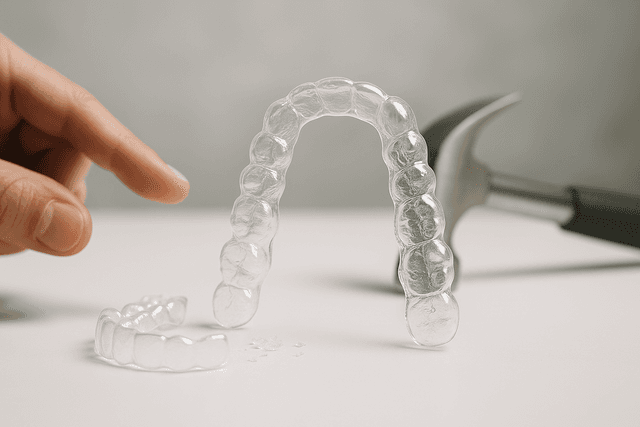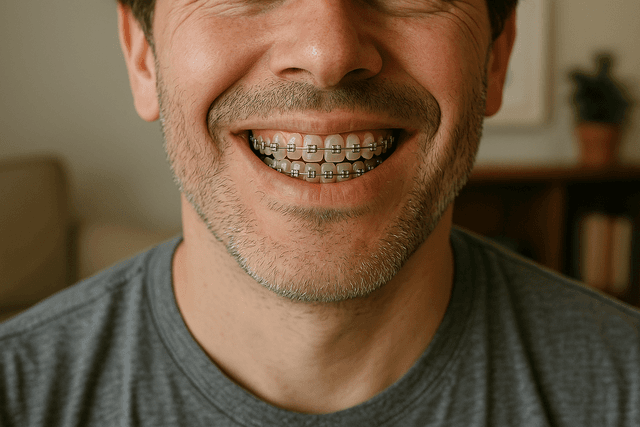Orthodontics
Everything You Need to Know About Braces
Braces have been a cornerstone of orthodontic care for decades, helping millions of people achieve straighter teeth and healthier smiles. They are more than a tool for cosmetic enhancement; braces address functional issues like bite alignment and uneven jaw pressure.
6 min read
Feb 06, 2025

Let’s be real: when most people think of braces, they picture a mouthful of metal and a few awkward teenage years. But the truth is, orthodontic treatment has come a long way. Whether you’re a teen, an adult considering braces for the first time, or a parent wondering when your child might need them, there are some important things you need to know about braces. We’ll walk you through everything—from types of braces to how to take care of your teeth and smile through the process. And yes, we’ll talk about whether braces hurt and what to expect during those first few weeks.
Why People Get Braces (And It’s Not Just About Looks)
Braces aren’t just about chasing a perfect smile. They’re also about function. If your bite’s off, your jaw feels sore, or your teeth are too crowded to clean properly, a good orthodontist might recommend braces. Straight teeth make it easier to chew, floss, brush, and yes—smile confidently. Orthodontic treatment helps prevent tooth decay, gum issues, and even jaw problems down the road.
The Process of Getting Braces
Thinking about braces? First, you’ll meet with an orthodontist who’ll take X-rays, photos, and possibly a digital scan of your mouth. From there, they’ll create a treatment plan that outlines how long it might take to get straighter teeth and which type of braces are best for you.
Once you’re ready, you’ll schedule an appointment to get your braces put on. During that visit, brackets will be bonded to each tooth and connected with wires. It’s a bit of a process, but most people are in and out in about two hours.
Brackets, Wires, and What’s Actually in Your Mouth
A bracket is the tiny square that gets glued to your tooth. It acts like a handle that lets the wire apply gentle, constant pressure to move teeth into place. The brackets and wires work together to slowly shift your teeth—and yes, that pressure is totally normal.
Some brackets are metal (hello, classic look), while others are ceramic, which blend in with your teeth and are less noticeable. No matter the material, the idea is the same: guide your teeth to where they’re supposed to be. Here’s a good read comparing metal braces vs. ceramic braces.
Braces Hurt—Let’s Talk About That
We won’t sugarcoat it—braces may cause discomfort, especially in the first week or two. You might feel soreness in your teeth and jaw because of the constant pressure. But this pain usually fades after a few days and can be managed with over-the-counter pain medication and orthodontic wax to soothe irritated gums or cheeks. Learn more about managing pain and discomfort with braces.
Pro tip: stick to soft foods for the first few days and avoid biting straight into anything too crunchy. Think mashed potatoes over tortilla chips.
Types of Braces Available Today
There are several different types of braces, and each comes with its own vibe and price tag.
Traditional metal braces: The most common and cost-effective. Great for major tooth movement.
Ceramic braces: Similar to traditional braces but with tooth-colored brackets. Less visible but slightly more fragile.
Lingual braces: These sit behind your teeth and are practically invisible—but they’re a bit more expensive and can be harder to clean.
Clear aligners: Technically not braces, but worth mentioning. These trays straighten teeth without brackets and wires.
If you’re interested in getting braces, your orthodontist will help you choose the best type of braces for your needs, lifestyle, and budget. You can also explore self-ligating vs. traditional braces to compare options.
How Long It Takes to Get Braces and See Results
Wondering how long it takes to get braces and when you’ll finally achieve the smile of your dreams? The process of getting braces put on usually takes a couple of hours, but the full braces treatment can last anywhere from 12 months to 3 years depending on your case.
For most people, the first few weeks feel the slowest. Then, over time, you’ll start seeing progress—and trust us, those small wins make the whole journey worth it.
Braces Cost: What to Expect
Braces cost can vary depending on the type of braces you choose, your location, and your orthodontist’s experience. Traditional metal braces tend to be the most affordable, while ceramic and lingual braces usually cost more. Don’t forget to factor in extras like retainers, orthodontic wax, and follow-up visits.
Many orthodontists offer financing options, so if you're considering braces, don’t let the cost scare you off. Ask questions about braces costs upfront so you’re clear on what’s included.
Taking Care of Your Braces (and Your Teeth)
Once you get your braces, daily care becomes even more important. Food particles can easily get stuck in your braces, especially around your brackets and wires. That means you’ll need to brush and floss with extra care to keep your teeth and gums healthy. Here's a great guide on caring for your braces.
Use a soft-bristled toothbrush, fluoride toothpaste, and make sure to brush around your braces after every meal. Don’t skip flossing—yes, it takes more time, but it helps prevent cavity trouble. Special dental floss or floss threaders can help you get between those tricky spots. Keeping up with your oral hygiene will help you avoid plaque buildup and keep your teeth with braces looking and feeling great.
You might also want to invest in a braces care kit that includes wax, dental floss, a proxy brush, and pain relievers. A care kit makes taking care of your braces way easier—especially in those first few weeks when everything feels new.
Can Food Get Stuck? Absolutely.
One of the most frustrating things is having food particles get stuck in your braces. It happens to the best of us. Avoid sticky, chewy, or hard foods that can dislodge a bracket or make cleaning harder. If something does get stuck, don’t panic—rinse your mouth, brush gently, and use a proxy brush if needed. For unexpected issues, here’s what to do in braces emergencies.
Braces and Flossing: Your New Best Friend
If you weren’t a floss fan before, now’s the time to embrace it. You’ll need to floss once a day, threading the floss under the wire between each tooth. It’s tedious, yes—but keeping your oral health on track while you wear braces is a non-negotiable.
What to Expect During Braces Appointments
After you get your braces, you’ll visit your orthodontist every 4–8 weeks for adjustments. These check-ups help your orthodontist monitor your progress and tighten your wires to keep your teeth moving in the right direction. It’s also a great time to ask questions about braces and bring up anything that feels off.
Best Age to Get Braces? Sooner Might Be Better
While people of all ages have braces, the best age to get braces is typically between 10 and 14—when most permanent teeth have come in, but the jaw is still developing. That said, you can straighten teeth at almost any age. Read more about braces for adults and why they’re becoming more popular.
After Braces: Hello, Retainers
Once your braces are removed, your orthodontic journey isn’t quite over. You’ll get a retainer to help keep your teeth in their new positions. You may need to wear the retainer full-time at first, then only at night. Wearing your retainer is key to keeping that straight smile intact for the long haul. Check out this braces and retainers aftercare guide.
Final Thoughts
There are a lot of things to know before getting braces, but it doesn’t have to be overwhelming. If you’re considering getting braces, start by scheduling a consultation with an experienced orthodontist. They’ll walk you through the process, give you expert advice, and answer all your questions—no judgment, no pressure.
At the end of the day, braces are more than just wires and brackets—they’re a way to straighten teeth, boost your confidence, and achieve the smile you’ve always wanted. Sure, the first week or two might be a little uncomfortable, and yes, food will definitely get stuck. But with the right care, patience, and a little bit of humor, you’ll make it through and come out smiling brighter than ever.
Ready to start your journey? Go ahead and schedule an appointment. We’ll be here to help every step of the way.
Read Next
Related Posts

Orthodontics
What Is Crack Resistant Aligner Material? Benefits, Types & More
If you’re wearing clear aligners or thinking about getting them, you’ve probably wondered how these thin, see-through trays can handle daily wear without snapping. The answer lies in something called crack resistant aligner material — a smart blend of science and design that helps your aligners stay strong, clear, and effective.
5 min read
Jun 06, 2025

Orthodontics
What Is Adult Orthodontia? A Clear Guide for Grown-Up Smiles
Straight talk: adult orthodontics isn’t just a trend—it’s a game-changer. Whether you're fixing long-standing bite issues, correcting crooked teeth, or just want to feel more confident flashing a grin, orthodontic treatment as an adult is more common (and more effective) than ever.
7 min read
Jun 03, 2025

Orthodontics
Comparing the Most Popular Types of Hawley Retainers
You’ve finally finished braces, your smile looks amazing—and now your orthodontist hands you a retainer. Wait, what? Yep, keeping your teeth in their new place is just as important as getting them there. And when it comes to doing that job well, Hawley retainers are one of the most trusted options out there.
5 min read
Jun 02, 2025
Don’t have time to research every dentist around you?
See why 30k+ patients trusted us